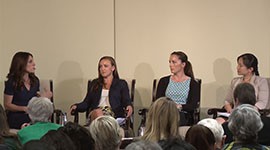Cronkite News has moved to a new home at cronkitenews.azpbs.org. Use this site to search archives from 2011 to May 2015. You can search the new site for current stories.
Military women gained since combat ban ended, still progress to be made
WASHINGTON – Rep. Martha McSally, R-Tucson, and an Air Force veteran, remembers when her branch of the military considered letting women serve as combat pilots back in the 1990s.
“We … had a chief of staff of the Air Force testifying before Congress against women flying in combat aircraft, and he would be asked things like, ‘So you would rather pick a less-qualified man over a more-qualified woman to go fly these aircraft?’” McSally recalled.
“And he would say things like – and I’m paraphrasing – ‘Yes I would, and I know that’s hard to justify but it’s just the way that I feel,’” said McSally, who went on to become the first female fighter pilot in the U.S. to fly in combat and the first to command a fighter squadron.
It would take another 20 years before the rest of the military agreed to lift the “general exclusion” bans on women in combat roles. McSally’s comments, recorded last week, were played Monday at a forum on the progress the military has made toward fully integrating women into military combat positions.
Two years after the Pentagon announced plans to lift the Direct Ground Combat Definition and Assignment Rule, speakers at the forum said there is still work to be done and attitudes to change.
Monday’s event included three panelists who were part of a Special Forces program that bent the combat exclusion rule before it was broken. The program recruited qualified female military personnel to aid squadrons in “Cultural Support Teams,” where they would interact with female civilians during combat operations in Iraq and Afghanistan.
“Shortly after I came back, I started hearing the whole thing about the general exclusion and I was like combat exclusion? I’ve been doing this for a while now,” said Sgt. 1st Class Meghan Malloy, one of the women in the CST program, with a laugh.
The biggest hurdle for integrating women into combat roles, said many of the panelists, is finding gender-neutral standards for combat positions. Those standards, they said, should not affect military readiness, but should directly apply to the job that the standards test for.
“We’re not lowering our standards nor are we compromising our military doctrine,” said Maj. Gen. Jacqueline Van Ovost, one of the first speakers. “The key is to have the right standard for the right occupation.”
Another issue often brought up by speakers was what the cohesion of male and female combat infantry units would look like after integration. Panelists debated whether this could be a real issue or only a way of protecting the “band of brothers” tradition.
“It’s about preservation, about maintenance of the existing order and that, to me, is an assumption that the existing organization is perfect and whatever we do to change it can only have negative or no impact if it’s done really, really well,” said Robert Egnell, a visiting professor at Georgetown University’s Institute for Women, Peace and Security.
“That, to me, is the wrong starting point when it comes to the inclusion of women in combat,” Egnell said. “I think it’s horrible to join an organization and feel that the only way I can impact it is negatively or not at all.”







